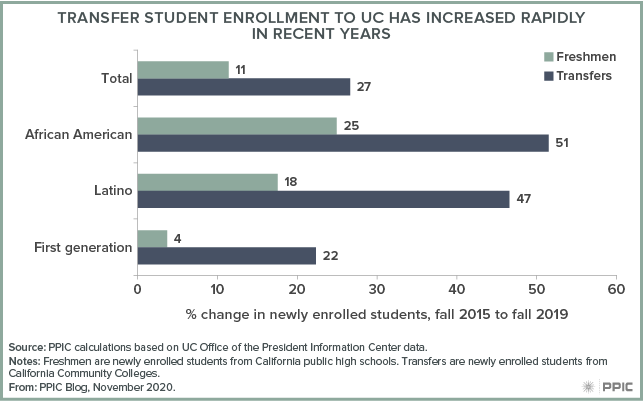Hans Johnson, director and senior fellow at the PPIC Higher Education Center, testified November 18, 2020, before the UC Regents and the Public Engagement Development Committee.
Here are his prepared remarks.
Thank you for the opportunity to present research recently completed at the Public Policy Institute of California on transfer from the community colleges. In this short presentation, I first provide some context regarding the role of transfer in our higher education system. I next discuss some highlights of PPIC’s recent work and then conclude with policy recommendations.
First, context. California’s promise of higher education for all depends on the community colleges. According to the Master Plan, the top-eighth of high school graduates are eligible for the University of California (UC), the top-third for California State University (CSU), and as Chancellor (and UC Regent) Ortiz Oakley likes to say—correctly—the top 100% are eligible for the community colleges. This means that California ranks fourth in the country in the share of recent high school graduates who enroll in a community college. But we rank 41st in the share who enroll directly into a four-year college or university.
Because the vast majority of students who enter community colleges do so intending to eventually earn a bachelor’s degree, we must ensure that the transfer pathway is effective and scaled to meet student demand. This transfer role is especially important for low-income students, first-generation college students, and students from underrepresented groups such as African Americans and Latinos, all of whom are more likely to start their higher education journey in a community college. Improving the transfer pathway would open the door to bachelor’s degrees for a more diverse population of students and ensure higher education still serves as a ladder for economic mobility.
Our recent report highlights barriers students have faced as they attempt to navigate the transfer pathway, identifies progress that has been made to overcome some of those barriers, and develops projections that show the potential for dramatic increases in the number of transfer-eligible students. The community college system is directing attention and resources at improving student pathways through community college and into four-year colleges—and has established ambitious goals for increasing transfer to UC and CSU in its Vision for Success.
The good news is that progress is being made. At the University of California, the number of transfer students has increased 27% over the past four years (faster than the growth of first-time freshmen at 11%). Increases in the number of African American and Latino transfer students have been even greater (51% and 47%, respectively).

Even so, too few community college students transfer to four-year universities. Specifically, we find:
- A large gap exists between the number of students who hope to transfer and those who do: only 19% of students with a stated transfer goal transfer within four years; 28% do so within six years.
- Equity gaps are a big problem. While Latino students represent 51% of students who declare a transfer goal, they represent 35% of those who transfer within four years; African American students represent 7% of those who declare a transfer goal and 5% of those who transfer within four years.
- Early progress is key. Transfer rates are higher among students who successfully complete 12 units and take any English or math course within their first three years: 26% transfer within four years and 39% within six years.
- Transfer rates are higher for students who successfully complete gateway transfer-level math (51% within four years) or accumulate 30 or more transferable units in their first year (73%), and for those who earn an Associate Degree for Transfer (50%).
- Recent reforms have made it possible for more students to successfully complete gateway math and English courses in their first year.
Reforms that eliminate prerequisite remedial courses—along with other efforts to streamline the transfer pathway—can help more community college students make tangible progress, potentially raising the number of transfer-eligible students by more than 50%.
Realizing this dramatic increase in the number of transfer-eligible students demands commitment on both ends. Community colleges and four-year colleges must work together to eliminate institutional barriers that keep students from becoming transfer eligible or from enrolling in a four-year college. Although the number of transfer enrollees is rising at both UC and CSU, these receiving institutions face capacity constraints that range from physical space to operating funds to staffing.
To further improve the transfer pathway, the California Community Colleges and four-year institutions must build systemwide agreements and help all transfer-eligible students make the transition. The Associate Degree for Transfer (ADT) and the Transfer Admission Guarantee (TAG) are steps in the right direction, but they are piecemeal and far from universal.
Governor Newsom and the legislature reached a budget deal in June that avoids immediate cuts to K–12 education and the community college system. However, the University of California and California State University might face significant revenue losses unless additional federal or state support materializes. This could affect the ability of these institutions to enroll an increasing number of transfer students.
To promote the state’s economic vitality and advance Californians’ economic well-being, the state and higher education institutions must work together to ensure that more students can attain a bachelor’s degree—and all the benefits that it brings.




